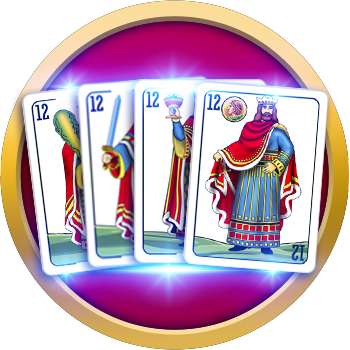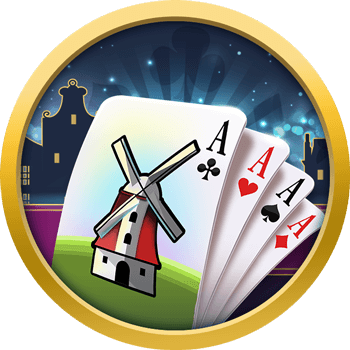Chinchon Online
Home »
Chinchón is a typical Spanish card game and belongs to the Gin Rummy family. It is played with a deck of 40 Spanish cards. The object of the game is to combine at least 3 cards in a row from the same suit or with the same value.
Learn about the rules, the value of the cards, and the objective of the game.
Participate in all the rankings and in the tournaments where you can play Chinchón online for free.

Game Introduction and History
The point of this Spanish game is to “match” /discard/ your cards in melds from one suit or 3 to 4 cards of the same value.
The name of the game coincides with the popular county in the southeast of Madrid, also with the popular drink made in the same locality. But this is not all! In Spanish, the name means also “swelling”. The most logical opinion about the name is that “Chinchon” comes exactly from “Gin” of the Gin-Rummy card game.
Some of the different names are: “Txintxon”, “Chinchorro”, “Conga” or “Golpeado”.
Chinchon Rules
Game Objective
The objective of the Chinchón game is to combine and meld the cards in stairs of the same suit (sequences) or in groups (sets) of 3 or more cards with the same value. The winner is determined by a point system, depending on the melding options.
Players
In VIP Games the possible options are game for 2,3 or 4 players. The game is individual and there are no teams.
Cards
The typical Spanish deck with 40 cards is used.
The card order is as follows:
- 1-2-3-4-5-6-7-Jack-Cavalry-King
Card Values
- Face cards (King, Cavalry, Jack) are worth 10 points each.
- Cards (Aces) are worth 1 point.
- Number cards are worth their face value.
- When it is not applied as wildcard the Ace of Coins is worth 25 points.
Card Combinations in Chinchón
- A set is a group of 3 or 4 cards with the same value; for example, three fours.
- A sequence is a group of cards from the same suit, which are ordered by rank; for example, 4-5-7 of coins.
Dealing of the cards
- The first dealer is selected randomly.
- The dealer for the next games is the next one in a counter-clockwise direction (the former forehand).
- Dealing is in a counter-clockwise direction.
- Each player receives 7 cards.
- After the cards dealt, the remaining ones form the Stock.
- The top card from the Stock is placed separately face-up, forming the beginning of the discard pile.
Drawing
To begin the first player takes one card from either the top of the Stockpile (without showing it to other players), or from the top card on the discard pile. This card is added to his/her hand.
Discarding
After drawing a card, the player discards one card from his hand and place it on top of the discard pile face up. The goal when draw and discard is to form combinations – sets and sequences in the hand.
Unlike the Rummy card game, if in the same turn player drew a card from the discard pile it is allowed to discard the same card.
Wildcard
When the Wildcard option is set for a session, the players can use the 1 of coins as a wildcard. For these sessions, sets containing 4 cards and sequences containing 7 cards is called “Chinchon”. The only limitation of using the wildcard is that it cannot be added to such combinations.
When laying off to a set, a player can act as follows:
- Add the wildcard to a 3-card set (as the missing natural card).
- Include the missing natural card to a set containing the wildcard.
- The natural card takes its place, and the wildcard is removed.
When laying off to a sequence, a player has the options:
- Add the wildcard to some of the ends of a sequence with 9 or fewer cards.
- When the wildcard is not at the ends of a sequence, add a natural card to one of the ends.
- When the wildcard is at one of the ends of a sequence, add a natural card to extend the sequence from this end. For example, in a (wildcard)-5-6-7 sequence, add 3 from the same suit. The result would be 3-(wildcard)-5-6-7.
- Add the natural card that is substituted by the wildcard. The natural card takes its place, and the wildcard is removed.
Laying off
After a player melds (referred to as ‘closing the hand’) there are no more drawing and discarding turns.
In case the closing player melded 6 cards, the other players can also meld and lay off as follows:
- All other players meld on the table the combinations they have (if any). This happens in turns, in the order of playing.
- If there are remaining cards in their hands, players can lay them off where possible to the combinations on the table.
- There is no limit to the number of cards a player may lay off.
- Laying off continues until no one can lay off a card anymore.
In case the closing player melded a 3-card and a 4-card combinations, or a Chinchon with a wildcard, the other players can do the following:
- They can meld their own combinations.
- They cannot lay off cards to any of the melded combinations.
In case the closing player melded a 7-card sequence (Chinchon) without using a wildcard, this player wins the session. In this case the losing players do not meld and lay off.
Scoring
To close the hand all players should complete at least one turn (discarded a card).
- When melding 6 cards, the value of the remaining card must be 3 or lower.
- Melding 7 cards, they are either in two combinations or in one sequence (Chinchon).
When the hand ends, no more turns are played. The scores for this hand are calculated individually for each player. The scoring depends on how the players melded, and on the cards that remained in their hands.
The closing player scores points as follows:
- Melding 6 cards: the value of the remaining card (up to 3)
- Melding 7 cards in two combinations: – 10 points
- Melding 7 cards in one sequence (Chinchon) using a wildcard: – 25 points
- Melding 7 cards in one sequence (Chinchon) without using a wildcard: directly winning the session, no matter what the current scores are
The rest of the players score points as follows:
- In general, a player scores the sum of the values of the cards remaining in his hand (which were not melded or laid off).
- In addition, if the Wildcard option is enabled and the wildcard remained in the hand of some player, this player scores additionally 25 points.
Session score
As described in the previous section, if a player melds Chinchon without a wildcard he wins the session.
When Chinchon is not announced, the session goes on until one of the players reaches the losing score set for the session. When this occurs, the player who has the lowest score at this moment becomes the winner of the session.
In case two or more players have the same lowest score, the winner should be the one of them who most recently closed a hand.




